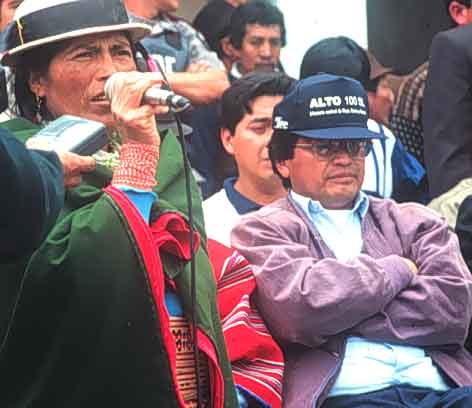|
GUAMOTE: 500 YEARS BACK TO THE FUTURE |
|
|
|
By Kashyapa A. S. Yapa |
|
At the end of the municipal council meeting, the indigenous leadership of Guamote -four council members and the mayor, Mariano Curicama- stayed back to converse. Suddenly, Mariano turned to me (I braced for another inquisitive onslaught.) "Look, you always say that Sri Lanka, your country, is on the other side of the world. But, how come you guys don't drown in the sea?" What a thing to ask! My tensed muscles flexed again and I was about to burst out... when I caught a glimpse of the serious faces of my audience. My laugh froze in mid-air: should I or shouldn't I? |
 |
Mariano Curicama is a privileged man, compared to the majority of his constituency. He has a high school diploma, but he scoffs at it, "I graduated from night school!" Short and broad shouldered, he is in late forties, but his square, clean-shaven face hides his age. Probably because he escaped the Andean weathering under the baking sun and the numbing cold, since his parents took him early to the city. Once he got back to the community, his fluent Spanish and the driver's license secured him a leadership role among the indigenous. And he garnered valuable contacts among the mestizos (the European-mixed population) as well, working as a chauffeur for government development officers. |
|
Mariano listens to doña Dolores |
|
In 1992, when the Ecuadorian indigenous movement began making inroads to the political arena with its own identity, Mariano rode the wave of enthusiasm. He became the first indigenous mayor of Guamote: a municipality with a vast rural sector where 95% of the total population, mostly indigenous, resides. His win awakened long dormant dreams among the hundreds of indigenous communities Ğlying scattered and abandoned in the barren Andean landscape. Every village wanted an access road, a school, a health center, electricity, potable water... The task ahead would stump even the most experienced engineer: but Mariano had to deliver. |
|
|
First he had to get the house in order. To overcome the (majority mestizo) staff resentment against a jefe indio, Mariano made everyone, from the accountant to the gatekeeper, report to him directly. He would show up wherever and whenever to check on the employees. The adamant municipal elephant finally bent the knees for its new controller. |
|
Having embarked on the biggest public works program ever in Guamote, he now needed money, materials and manpower. Guamote is considered one of the poorest municipalities in Ecuador. But Mariano saw what the economists overlooked. The meager funds available he would spend only on materials. For the manual labor, he employed the minga, the traditional volunteer community work. Once the villagers see the materials piled up in their community, they would enthusiastically dig the trenches, lay the bricks or mix the concrete. |
|
Yet, the typical engineering designs do not permit the efficient use of manpower in large scale, because they are prepared with machinery in mind. And it seemed impossible finding a qualified technician to direct and supervise the minga workers, without bringing back the memories of huasipungo (the practice with which land barons exploited the indigenous in the past). Fatigued and frustrated from running it all by himself, Mariano enthusiastically accepted my offer to serve as a volunteer engineer for the municipality. |
|
However, my first couple of months in Guamote were a complete failure. I could not get across to Mariano the philosophy behind my revolutionary engineering designs, based on optimal use of local resources to cut costs. In the field, the villagers would convince him, and revert to the familiar "standard" designs, causing huge time and cost over-runs. The problem arose because Mariano did not confide enough in me to hand over the supervision of indigenous workers. |
|
|
Now, this same fellow asks me, why don't we drown on the other side of the earth! The eager looks all around convinced me that a laugh would not be welcome here. Suddenly an idea struck me: may be they really do not know how this world functions! I took a long breath, dived deep into my high school physics memories and began explaining how the gravitational forces keep water from spilling the earth's borders... |
|
Ever since, the question of who supervises the engineering works never came up. Mariano would take me to a village and present me, "This is just another indio, only found his way some 500 years later! |